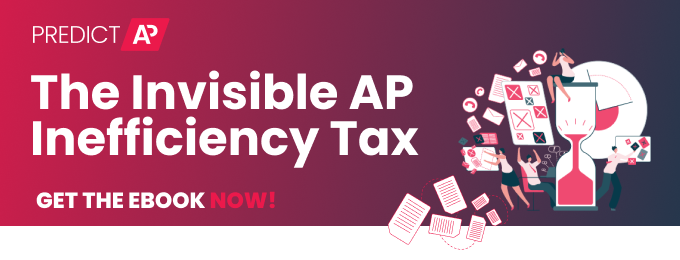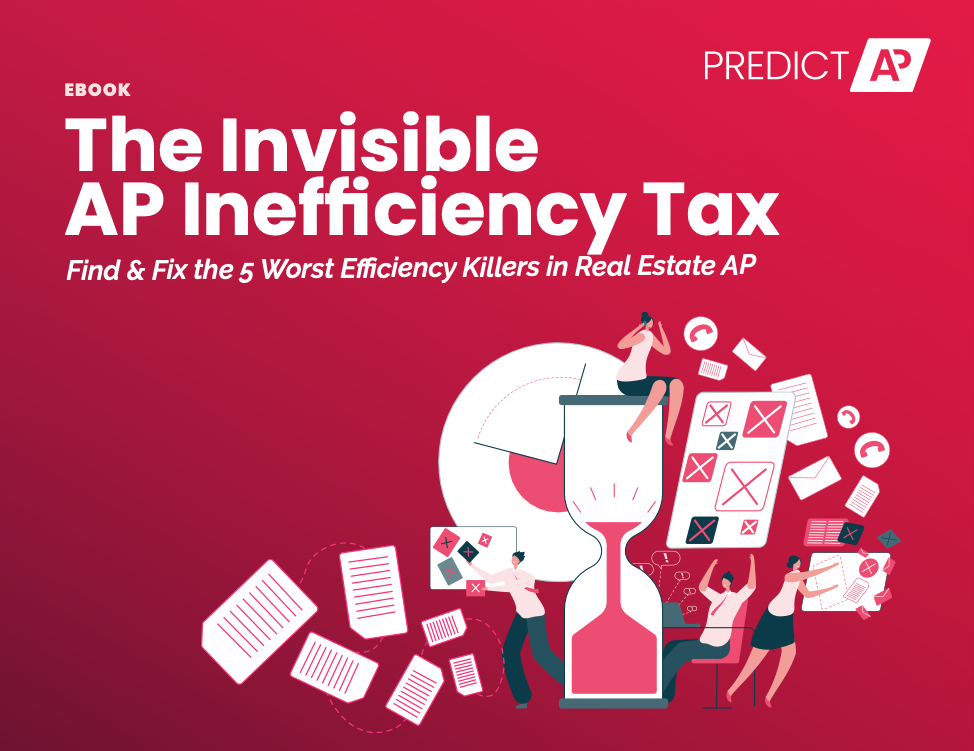Share this
The Invisible Tax on Accounts Payable Efficiency
by Karo Sadowicz on Aug 15, 2022 10:38:05 AM
Improving accounts payable efficiency is a high priority for real estate accounting teams. But the most common metrics for measuring AP performance: invoice turnaround time or invoices processed per FTE (full time employee), are often too granular to show the full impact of inefficiently run invoice processing.
While missed payment due dates and angry vendors are obvious and serious indicators of a problem, there are other key signals that finance and accounting leaders should watch closely.
The 3 harbingers of AP inefficiency
In our new ebook, “The Invisible AP Inefficiency Tax: Find & Fix The 5 Worst Efficiency Killers in Real Estate AP,” we highlight the five worst efficiency killers, along with the signs that your accounts payable processes demand a closer look.
Unprecedented AP employee turnover
According to a recent joint report by AvidXchange and IOFM, less than half of AP professionals are satisfied with their jobs, and more than a third have looked for new employment in the last six months. It’s not just the “Great Resignation” affecting all industries after COVID-19. They’re tired of repetitive, manual work with no real prospects.
Underwhelming tech ROI
Despite billions of dollars spent on AP automation adoption, the promise of dramatic efficiencies has only been realized for some parts of the accounting organizations. Accounts payable has largely been left behind, with manual data entry still creating bottlenecks that keep real estate organizations from realizing the full potential of their tech investments.
No time for high value work
Full-time AP professionals feel under-utilized and overworked when focused on monotonous, low-value tasks. Property managers and other back office roles that balance invoice processing against other duties and tenant needs are stuck at their desks, doing clerical work, instead of the work that ensures happy tenants and lease renewals.
What are the worst AP efficiency killers?
These common time and resource drains lurk at every stage of your process, often working in tandem to conceal the real state of your AP operations. We’ve briefly highlighted them here.
Tribal Knowledge Silos
A lack of systematized, centralized means of capturing, codifying, and transferring the knowledge required to process and code invoices for payment. This makes training and onboarding new employees slow and challenging, while making any team turnover very disruptive due to knowledge loss. Tribal knowledge management can help prevent silos and bottlenecks downstream.
Offline Approval Detours
The processes you have defined in theory put into daily practice run into snags and missing information, with your AP team doing their best to fill in the gaps in tech and knowledge on the fly. The gap between the process you think you have, and what actually happens during invoice processing may surprise you.
Bespoke Tech Solutions
What’s tailored perfectly today isn’t guaranteed to fit in a few years. That’s as true of a bespoke suit as it is of a highly customized solution implementation. Your tech toolkit has been customized to a specific iteration of your organization, but is no longer suited to its needs.
Persistent Legacy Processes
A process designed for a moment in time in your organization is not serving today’s goals. It’s solving for problems that have better solutions today, or that no longer exist at all.
The ERP Ecosystem Trap
You’re heavily invested in a platform ecosystem that might have some serious gaps or limitations. Parts of it work, some of it works well, but too many decisions were made around integration and compatibility, and your people and process have to pick up the slack wherever the platform falls short.
How to find and squash your AP efficiency killers
The full cost of AP inefficiency can be hard to calculate without seeing the full picture, or how these sometimes less-than-obvious factors contribute. But taking a more comprehensive look can help you gauge just how costly your AP inefficiency tax can be for the business.
Download our ebook to learn more about how inefficiency manifests itself and how to unmask each inefficiency killer, and to boost your AP team’s output by making their work a little less, well, taxing.
Share this
- AP Efficiency (31)
- PredictAP News (25)
- AP Best Practices (22)
- AI Best Practices (20)
- Real Estate Accounts Payable (20)
- Real Estate Industry (14)
- Invoice Coding (11)
- Customers (9)
- Invoice Capture (9)
- Accounts Payable Staffing & Hiring (7)
- Partners (2)
- Knowledge Management (1)
- Senior Living (1)
- Yardi (1)
- December 2025 (4)
- November 2025 (7)
- October 2025 (4)
- September 2025 (5)
- August 2025 (5)
- July 2025 (6)
- June 2025 (3)
- May 2025 (2)
- April 2025 (2)
- March 2025 (2)
- February 2025 (2)
- January 2025 (1)
- December 2024 (1)
- November 2024 (1)
- September 2024 (1)
- August 2024 (3)
- July 2024 (1)
- June 2024 (2)
- May 2024 (3)
- April 2024 (1)
- January 2024 (1)
- March 2023 (3)
- February 2023 (1)
- November 2022 (1)
- September 2022 (1)
- August 2022 (2)
- July 2022 (1)
- May 2022 (2)
- April 2022 (2)
- February 2022 (2)
- December 2021 (1)
- November 2021 (1)
- April 2021 (1)
- March 2021 (1)

